
Phyllomedusa burmeisteri, also known as Burmeister's leaf frog and common walking leaf frog, is a species of frog native to the Atlantic Forest biome in Brazil.

Phyllomedusa bicolor, the giant leaf frog, bicolor tree-frog, giant monkey frog, or waxy-monkey treefrog, is a species of leaf frog. It can be found in the Amazon basin of Brazil, Colombia (Amazonas), Bolivia, and Peru, and can also be found in the Guianan Region of Venezuela and the Guianas, and in Cerrado of the state of Maranhão in Brazil.

Phyllomedusa sauvagii, the waxy monkey leaf frog or waxy monkey tree frog, is a species of frog in the subfamily Phyllomedusinae. It is native to South America, where it occurs in Argentina, Bolivia, Paraguay and Brazil. This species is arboreal, living in the vegetation of the Gran Chaco.

Hyloxalus nexipus is a species of frog in the family Dendrobatidae. It is found on eastern slopes and foothills of the Andes from southeastern Ecuador south to the region of Yurimaguas in Peru.
The Pilalo tree frog is a species of frog in the family Hylidae endemic to Ecuador. Its natural habitats are subtropical or tropical moist montane forests and rivers. It has been observed between 2300 and 2600 meters above sea level. It is threatened by habitat loss.
Phyllomedusa coelestis is a species of frog in the subfamily Phyllomedusinae. It is found in Colombia, Ecuador, and Peru between 200 and 1000 meters above sea level.

Phyllomedusa distincta is a species of frog in the subfamily Phyllomedusinae, endemic to Brazil. It has been observed as high as 1000 meters above sea level.
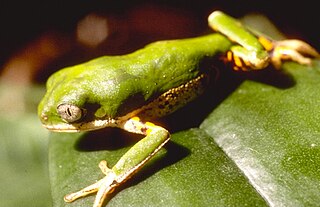
Pithecopus hypochondrialis, the northern orange-legged leaf frog or tiger-legged monkey frog, is a species of frog in the subfamily Phyllomedusinae found in South America. Its natural habitats are subtropical or tropical dry forests, subtropical or tropical moist lowland forests, subtropical or tropical moist shrubland, subtropical or tropical seasonally wet or flooded lowland grassland, intermittent freshwater marshes, pastureland, plantations, rural gardens, urban areas, and heavily degraded former forests. This frog has also been observed in cities. It has been observed as high as 1500 meters above sea level.
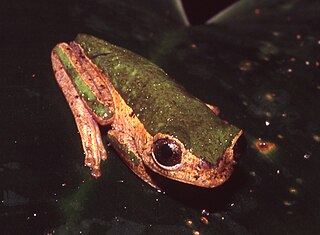
Pithecopus palliatus is a species of frog in the subfamily Phyllomedusinae. It is found in Bolivia, Brazil, Ecuador, Peru, and possibly Colombia. Its natural habitats are subtropical or tropical moist lowland forests and intermittent freshwater marshes. It is threatened by habitat loss. It has been observed between 100 and 400 meters above sea level.

Phyllomedusa tarsius, the brownbelly leaf frog or tarsier leaf frog, is a species of frog in the subfamily Phyllomedusinae. It is found in Brazil, Colombia, Ecuador, Peru, and Venezuela, and possibly Bolivia and Guyana. This frog has been observed as high as 800 meters above sea level.
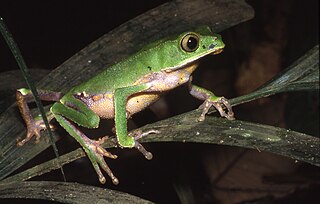
The white-lined leaf frog is a species of frog in the subfamily Phyllomedusinae. It is found in northern South America. Its natural habitats are subtropical or tropical moist lowland forest, subtropical or tropical swampland, rivers, and freshwater marshes. It is threatened by habitat loss.
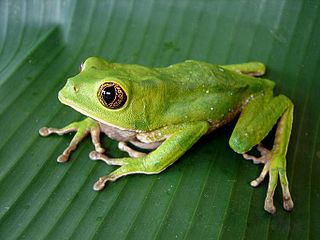
Phyllomedusa venusta is a species of frog in the subfamily Phyllomedusinae, found in Colombia and Panama. Scientists have seen it between 800 and 1400 meters above sea level.
Philautus cornutus is a species of frog in the family Rhacophoridae. It is endemic to Indonesia. It has been observed 1529 and 1907 meters above sea level.

Pseudophilautus decoris, commonly known as the elegant shrub frog, is a species of frogs in the family Rhacophoridae. It is endemic to Sri Lanka.

Zhangixalus arboreus, also known as the forest green tree frog and Kinugasa flying frog, is a species of frog in the family Rhacophoridae endemic to Japan, where it has been observed on Honshu island, as high as 2000 meters above sea level.
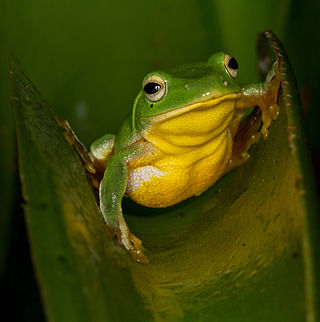
The Taipei tree frog is a species of frog in the family Rhacophoridae. It is endemic to central and northern Taiwan. It is a medium-sized tree frog; females are 4.5–5.5 cm (1.8–2.2 in) in snout-vent length, and males are slightly smaller 3.5–4.5 cm (1.4–1.8 in).
Dendropsophus reichlei is a frog in the family Hylidae endemic to Bolivia, Peru, and Brazil.

Pithecopus azureus is a species of frog in the subfamily Phyllomedusinae that lives in Brazil, Paraguay, Argentina, Bolivia, and Peru.
Phyllomedusa neildi is a species of frog in the family Hylidae endemic to Venezuela. Scientists know this frog solely from its type locality: Sierra de San Luís. This frog has been observed between 550 and 1150 meters above sea level.
Phyllomedusa chaparroi is a species of treefrog in the subfamily Phyllomedusinae endemic to Peru. Scientists have only seen it in two places. This frog has been observed between 537 and 650 meters above sea level.















